Best 10 Free Competitive Intelligence Tools in 2025
You are running a business, and you keep wondering what your competitors are up to. Are they dropping their prices? Did they launch a new product overnight? Is their website about to get a major update?
Checking competitor websites every single day is a waste of your time. It is impossible to do manually without missing something important. This is why you need a reliable competitive intelligence tool.
This blog explores the 10 best free competitive intelligence tools you can use in 2025.
What Is a Competitive Intelligence Tool?
A competitive intelligence tool is a piece of software that automatically gathers and analyzes information about your market, industry trends, and business activity. These tools eliminate manual secondary research.
They solve the problem of missed opportunities by automating data collection from competitor websites and other public sources. Competitive intelligence tools like ScrapX, Visualping, SimilarWeb, and others automate this process. This lets your sales team and product marketing department quickly build battle cards and react to sudden market dynamics.
List of the Best Free Competitive Intelligence Tools in 2025
1. ScrapX
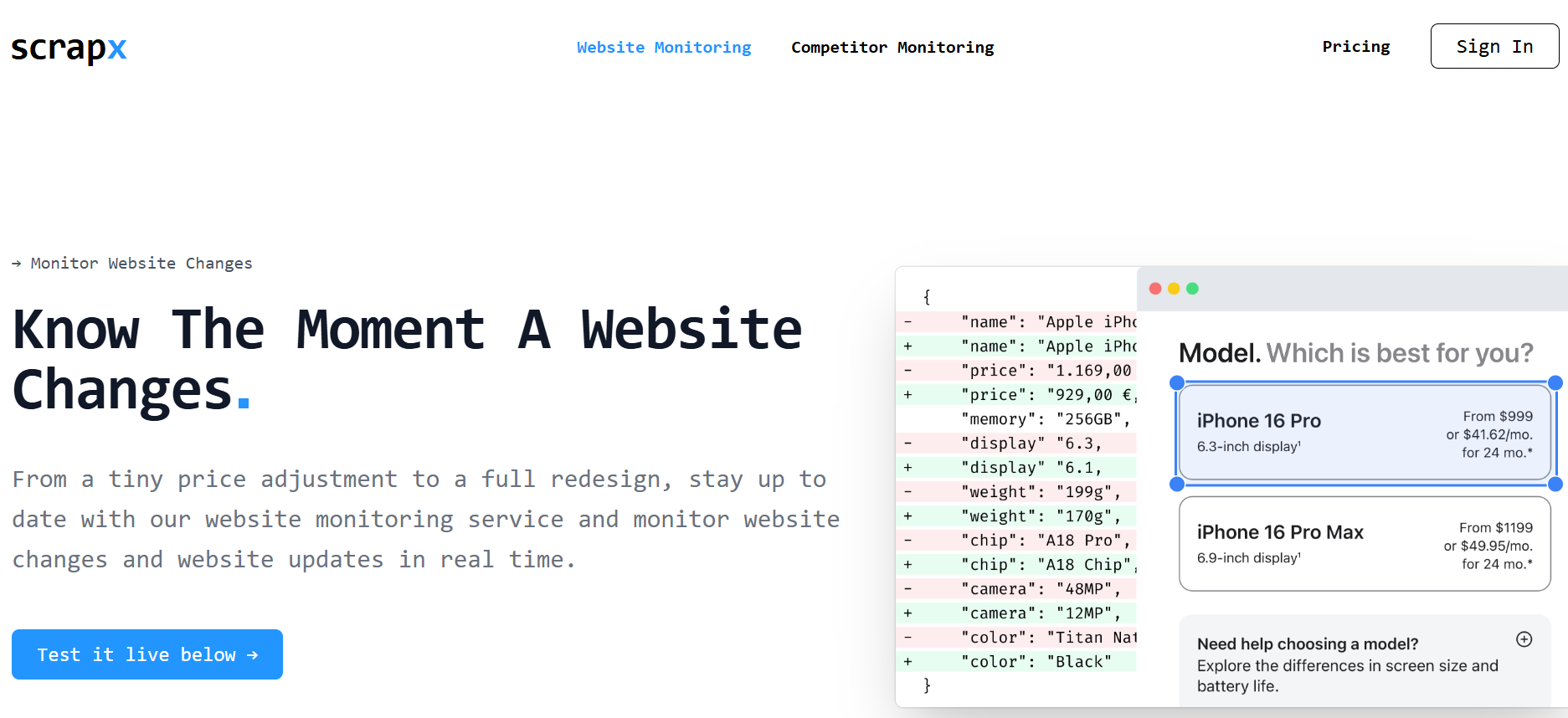
Best For
ScrapX is built for people who need simple, reliable, and automated website change alerts and data extraction. If you hate manually refreshing competitor websites, this tool is for you. ScrapX is one of the top competitive intelligence tools for precision monitoring.
ScrapX is best for technical and marketing teams that need precise, customizable alerts on website changes, especially price shifts, new content, and technical updates like SSL cert alerts. This is a must-have tool for monitoring content updates for your content marketing efforts.
Features of ScrapX
ScrapX offers various features to support your competitive analysis efforts. It monitors what you need, how you need it.
- Track competitor pricing across websites
- Textual Change Detection
- SEO Competitive Intelligence
- Visual Change Detection
- Excel Reports and Webhooks
- Data Extraction
- AI Summary of Changes
- Transformers (CSS/JS selectors for fine-grained diffs)
- Monitor SERP competitors
- SSL Certificate Alerts
- Subdomain Change Alerts
- Price Change Notifications and Alerts
ScrapX Top 3 Features for Competitive Intelligence
1. Highly Accurate Textual and Visual Alerts
ScrapX offers high-precision change detection. It is the core of this competitive intelligence tool. This is critical for monitoring competitor pricing pages without distraction.
2. Subdomain and SSL Monitoring for Security
ScrapX helps security teams by alerting you to new or changed sub-domains on your own side. It also notifies you about impending SSL certificate expiry dates. This prevents downtime and protects your business activity.
3. Data Transformers for Sales Enablement
ScrapX’s Transformers feature cleans up and formats the extracted data for immediate use. This makes it ready for your sales team to integrate into their CRM for faster sales enablement.
Pros of ScrapX for Competitive Intelligence
- Focuses purely on deep, actionable website change detection
- You can get notifications through email or webhooks, making it easy to fit into your existing process
- The pricing is simple and affordable, starting with a free plan
- Covers multiple tracking methods: text, visual, and structured data
- Supports price history charts, price alerts, and Excel reporting
- Easy integration with web scraping workflows and dynamic pricing engines through webhooks or APIs
- Helps track competitors’ stock availability, product URLs, and pricing pages with high data accuracy
Cons of ScrapX
- Requires manual CSS selectors for very complex pages (learning curve for non-tech users).
Pricing of ScrapX
ScrapX has a straightforward pricing structure:
- Free: $0/month
- Basic: $11/month
- Pro: $29/month
- Mega: $89/month
Final Verdict
ScrapX is the best tool for anyone who wants to monitor a competitor’s website content without spending money. For tracking price changes, job postings, or product updates, this tool is the simplest and most direct path to getting accurate alerts.
2. Visualping
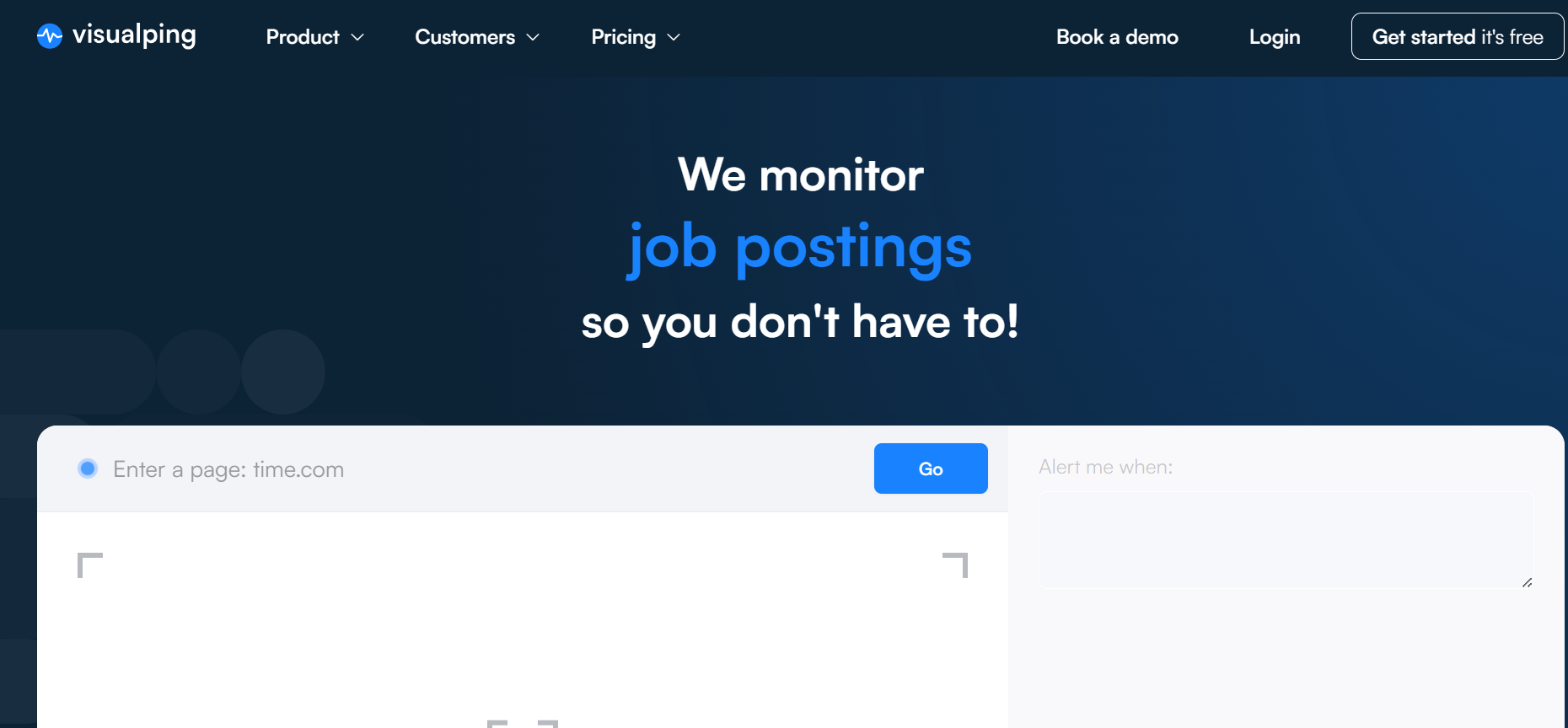
Best For
Visualping is best for individuals and small marketing teams who need to track a few key competitor pages (like pricing or homepage messaging) with highly accurate visual and text alerts.
Features of Visualping
- Visual and Text Change Detection
- AI-Generated Summaries
- Email and App Alerts
- Targeted Monitoring
- Multiple Monitoring Modes
- Basic reporting to review past changes
Visualping Top 3 Features for Competitive Intelligence
1. AI-Powered Change Summaries
Visualping's AI summarizes the update for you, often distilling a long paragraph of changes into a two-or three-line explanation. This speeds up your response time to market dynamics.
2. Flexible Change Monitoring
Visualping gives you options for how to monitor: by the full screen, by a specific element, or by the text. This flexibility is crucial for precise competitive intelligence gathering.
3. Visual Comparison with Highlights
Every alert comes with a side-by-side screenshot showing the 'before' and 'after' versions of the page, with the exact changes highlighted.
Pros of Visualping for Competitive Intelligence
- Very easy to set up and use; great for beginners
- Works across competitor websites, product URLs, and pricing pages
- Customizable alerts
Cons of Visualping
- The free plan is limited to checking pages once per day
- Monitoring frequency gets costly quickly on paid plans if you need real-time alerts
Pricing of Visualping
Visualping offers a tiered pricing structure:
- Free: 5 pages per month
- Starter: $14/month (1,000 checks per month)
- Business: Starts at $140/month (20,000 checks per month)
Final Verdict
Visualping is a reliable choice for non-technical users who prioritize simplicity and visual proof of changes. If your main goal is to know what the page looks like after an update, Visualping is the tool to start with for competitive intelligence monitoring.
3. SimilarWeb
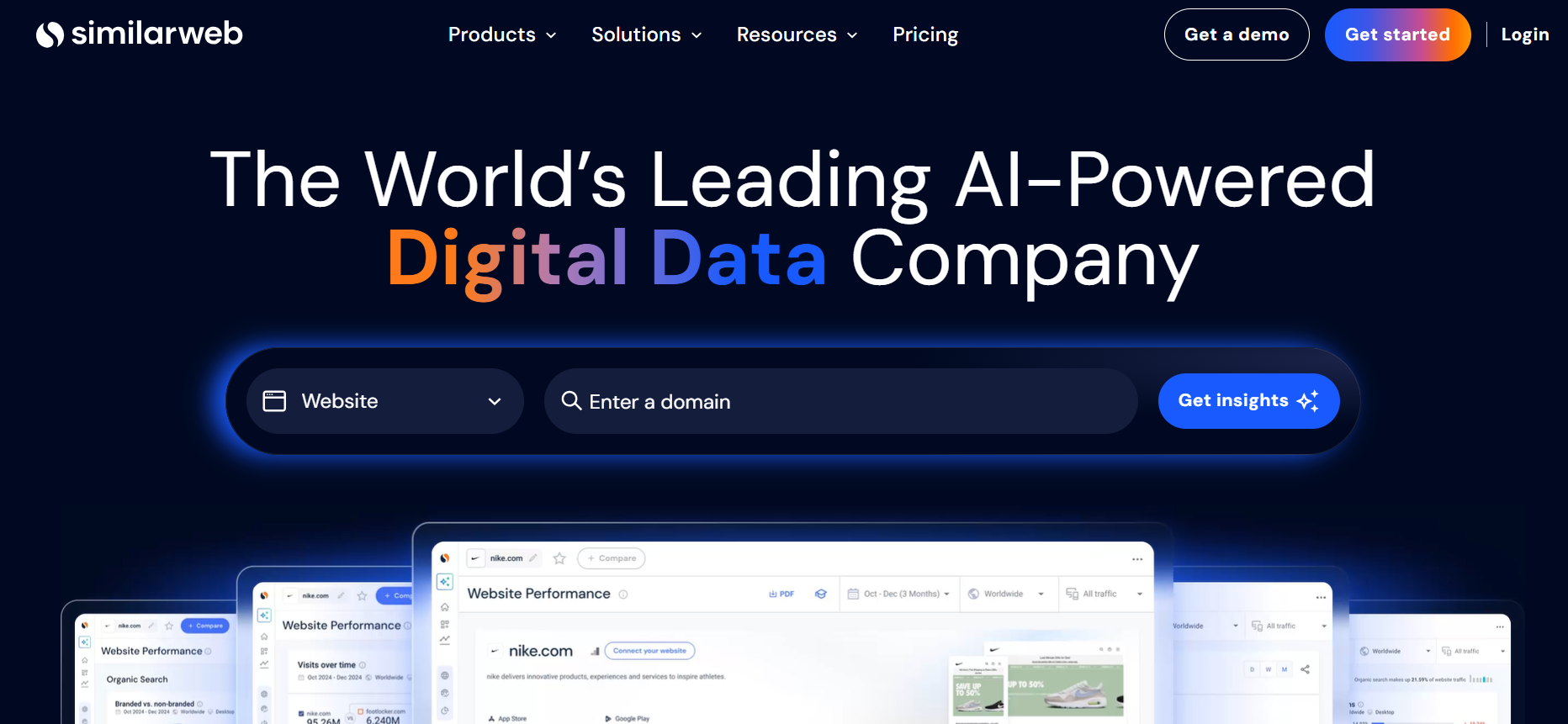
Best For
SimilarWeb is the go-to platform for digital intelligence and competitive benchmarking. It’s best for marketing teams, SEO specialists, market researchers, and business strategists who need to analyze and understand their competitors' online performance, traffic sources, and audience behavior.
Features of SimilarWeb
- Traffic & Engagement Analysis
- Keyword Strategy
- Industry & Market Benchmarking
- Audience Insights
- Competitor Analysis
- Customer Demographics
SimilarWeb Top 3 Features for Competitive Intelligence
1. Traffic Channel Breakdown
Traffic channel breakdown shows you exactly where your competitors' website visitors are coming from. It breaks down traffic by channels like Direct, Search, Referrals, and Paid Ads.
2. Keyword Gap Analysis
The Keyword Gap tool lets you compare your website's keywords against up to four competitors at once, so you can instantly find keyword opportunities.
3. Digital Market Share & Industry Analysis
SimilarWeb lets you define a custom industry and then shows you the total website traffic share each competitor commands within that market.
Pros of SimilarWeb for Competitive Intelligence
- Broad, multi-channel overview of competitors' entire digital marketing strategy, not just SEO
- Extensive historical data, allowing for in-depth trend analysis over many months
Cons of SimilarWeb
- The subscription cost for the full suite of features is high, often excluding small businesses and startups
- Data for very small or highly niche websites can be based on estimates and may not be completely accurate
Pricing of SimilarWeb
SimilarWeb offers the following pricing plans for Entrepreneurs:
- Competitive Intelligence: $125 per month billed annually or $199 per month
- Competitive Intel & SEO: $335 per month billed annually or $399 per month
- Competitive Intel, SEO & Ads: $540 per month billed annually or $649 per month
Final Verdict
SimilarWeb provides a comprehensive view of the online landscape, making it an essential tool for any business looking to benchmark and strategically grow. The wealth of data, particularly the multi-channel insights, is second to none. However, be aware that the price point for the full suite of features means it's a significant investment, and for smaller, low-traffic websites, the data estimates can sometimes have a slight drawback in accuracy.
4. ChangeTower
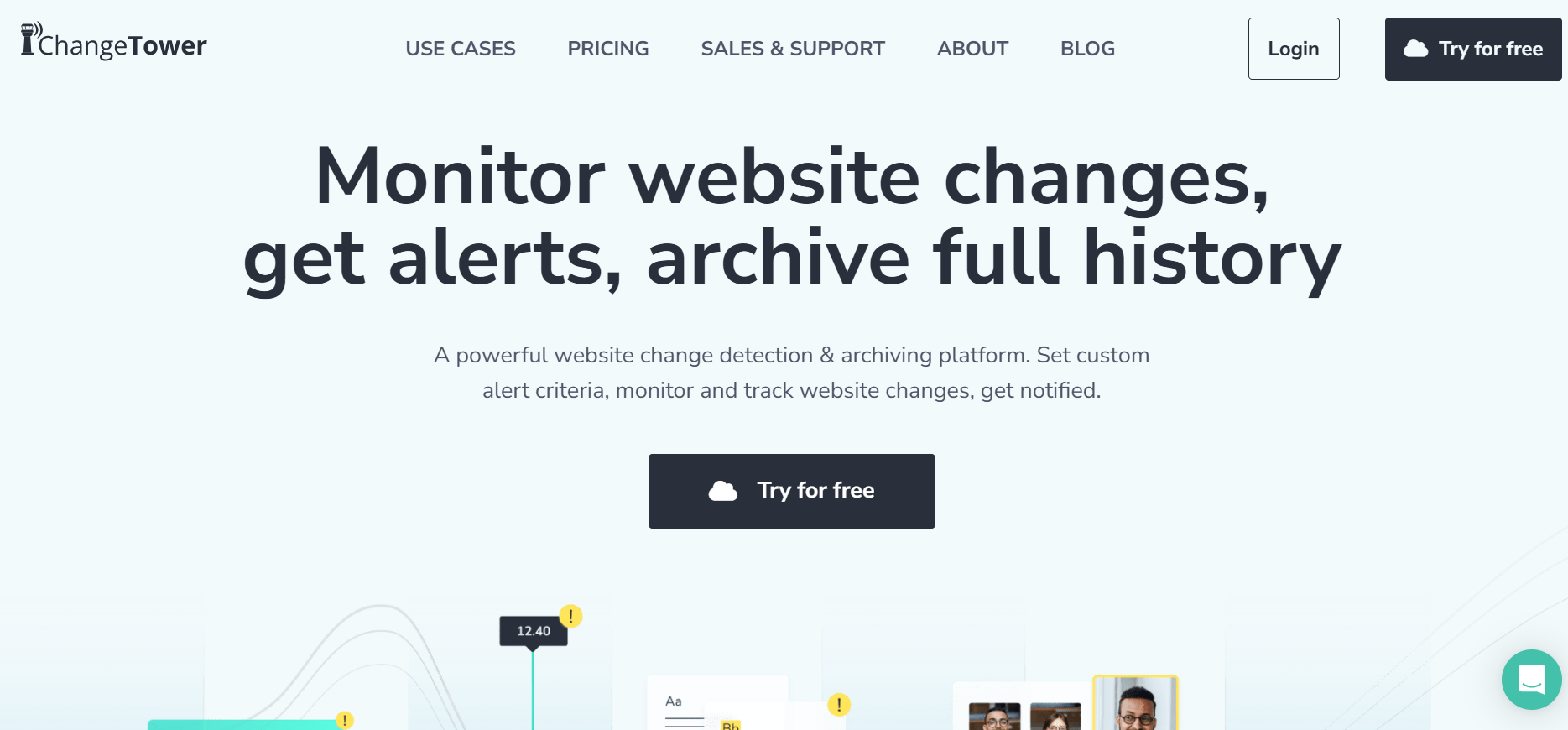
Best For
ChangeTower is best for businesses, SEO professionals, and legal/compliance teams that need to monitor entire domains or specific web elements for both content and technical changes with an emphasis on archival and detailed reporting.
Features of ChangeTower
- Content Monitoring
- Visual Monitoring
- Code & HTML Monitoring
- Stock Availability Tracking
- Price History Charts
- Domain & SSL Monitoring
- Multi-Condition Alerts
ChangeTower Top 3 Features for Competitive Intelligence
1. Keyword and Code Change Alerts
ChangeTower lets you monitor a competitor's page specifically for the appearance of certain keywords, like "new feature," "pricing update," or "enterprise plan."
2. Full-Page Visual Snapshots
When a competitor changes their website design, messaging, or calls to action, the visual snapshot feature captures and archives the "before" and "after" images.
3. Domain and Subpage Monitoring
ChangeTower's ability to scan and monitor an entire domain is valuable for keeping a pulse on a competitor’s expansion. It instantly notifies you when they publish a new blog post, launch a new landing page, or open a careers page with new job listings.
Pros of ChangeTower for Competitive Intelligence
- Easy-to-use cloud-based price monitoring software
- Useful for seo competitive intelligence and monitoring SERP competitors
Cons of ChangeTower
- Limited predictive insights compared to AI-driven price tracking platforms
- May not scale as well for enterprises with very large catalogs
- Reporting features are basic compared to enterprise-level competitors
Pricing of ChangeTower
ChangeTower offers tiered subscription plans:
- Free: $0, 6 checks per day
- Power User: $9 for 1500 checks per month
- Enterprise: $299 per month
Final Verdict
ChangeTower offers detailed, verifiable change history and a high degree of customization in its alerts, particularly for SEO, compliance, or intensive competitive tracking. The ability to monitor specific code elements and the robust archival feature are major selling points, though the cost structure requires careful planning to manage the usage of monthly check credits.
5. Distill.io
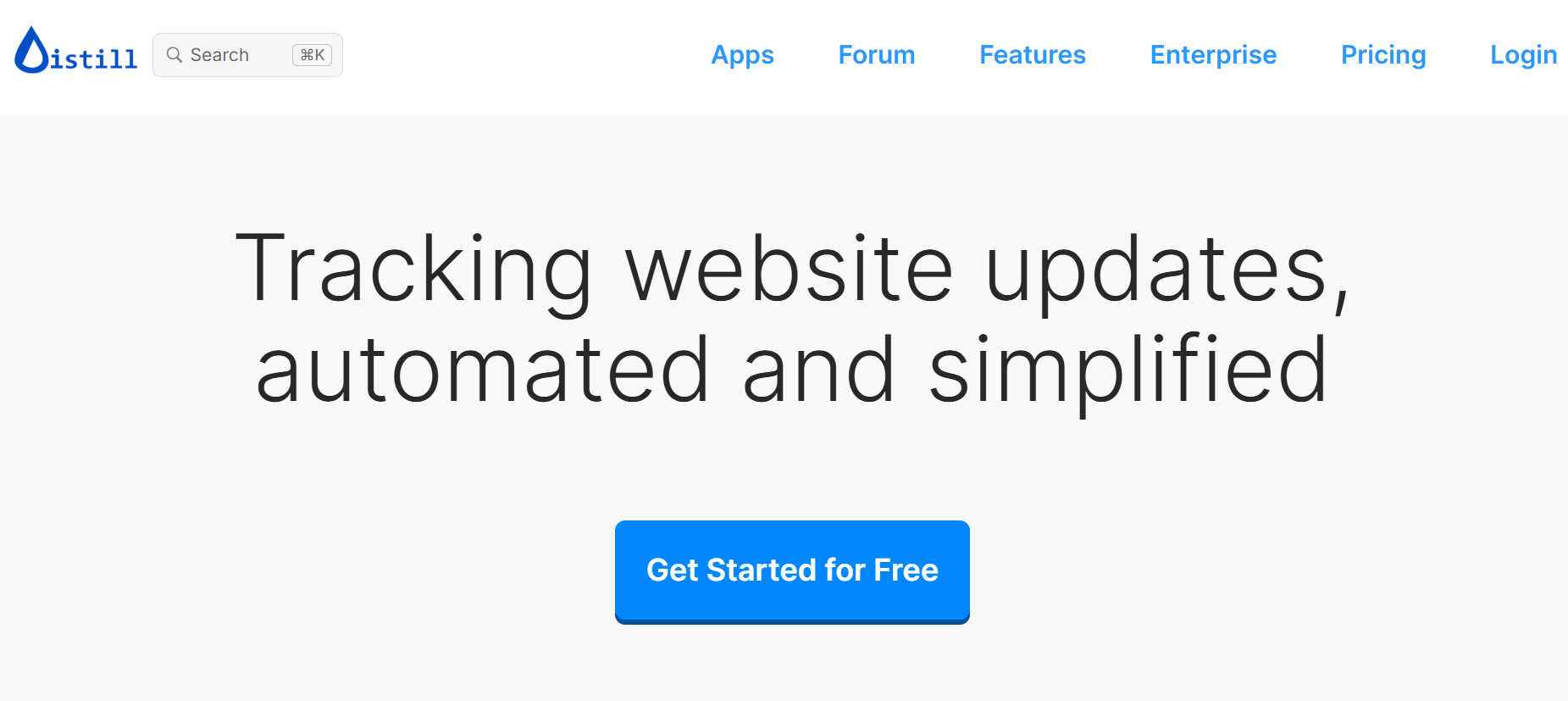
Best For
Distill.io is best for individual users, researchers, and small teams who need a highly flexible and accessible tool to monitor website changes, often starting with a local browser extension. It is ideal for tracking very specific elements on a page, like a single price point, a stock alert, or a small section of a changelog.
Features of Distill.io
- Local & Cloud Monitoring
- Visual Selector
- Conditions and Filters
- Allows Recording a Sequence of Actions
- Multiple Alert Channels
- Version Histories
Distill.io Top 3 Features for Competitive Intelligence
1. Element Selection for Targeted Tracking
Instead of monitoring an entire competitor webpage, Distill uses a visual selection tool to highlight just one piece of information, like the price field on a product page or the date of the last press release.
2. Macros for Monitoring Dynamic Content
Distill's Macros allow you to record steps, such as entering a username/password or selecting a specific product filter, enabling you to successfully monitor dynamic or protected content.
3. Local and Cloud Flexibility
Distill gives users the choice to run checks locally on their browser (free and unlimited) or on Distill’s cloud servers (24/7 monitoring even when your computer is off).
Pros of Distill.io for Competitive Intelligence
- Offers clean and relevant alerts
- Offers a generous free plan, making it easy to get started
- Supports multiple notification channels
Cons of Distill.io
- Features such as macro recordings and proxy rotation are gated to Starter plans and above.
- Support options can be limited
Pricing of Distill.io
- Free: $0/month (25 monitors, 6-hour checks).
- Starter: $15/month.
- Professional: $35/month.
- Flexi: Starting from $80/month.
Final Verdict
Distill.io is a precision-focused change monitoring tool and is highly recommended for anyone who needs to start tracking a few critical competitor data points immediately and on a budget. The initial free browser extension is a great entry point, but be aware that securing reliable, high-speed, 24/7 competitive intelligence will require moving to one of their paid cloud plans.
6. Sken.io
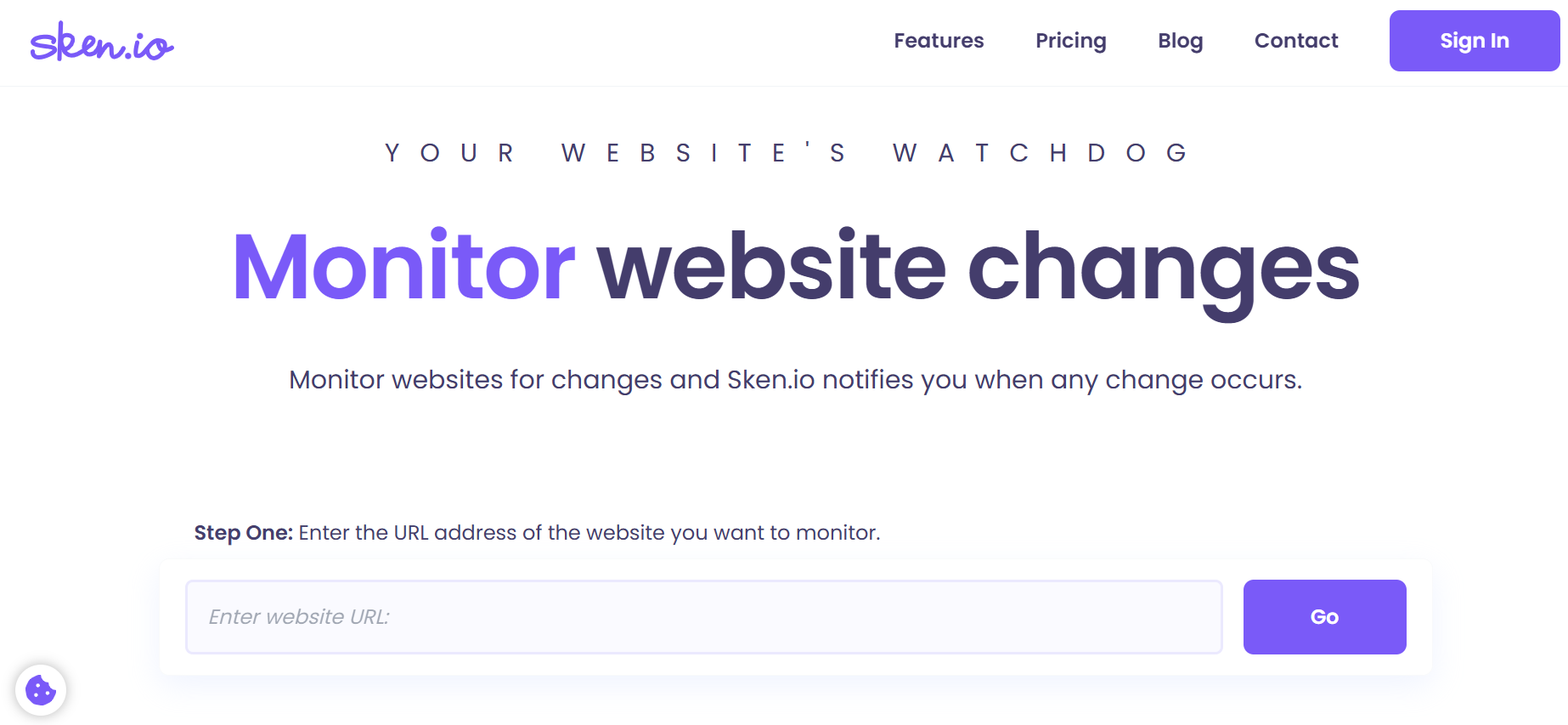
Best For
Sken.io is best for small businesses, individuals, and competitive analysis specialists looking for an extremely affordable and user-friendly website change monitoring tool with a high minimum check frequency.
Features of Sken.io
- Customizable Monitoring Area
- High-Frequency Checks
- Change Comparison
- Element Selection Tool
- Mobile and Push Notifications
- Organize Monitoring Tasks
Sken.io Top 3 Features for Competitive Intelligence
1. Precise Element Selection
Sken’s selection tool allows you to choose what to monitor, for instance, only the main product price, the shipping cost field, or the number of reviews.
2. One-Minute Check Frequency
On its paid plans, Sken.io offers monitoring as frequently as every one minute for highly competitive e-commerce or retail industries where a competitor’s flash sale or price adjustment may only last for a short period.
3. Chart Preview for Numeric Values
Sken.io can recognize and track numerical values and offers a chart preview of these numbers over time to visualize competitor pricing trends.
Pros of Sken.io for Competitive Intelligence
- Simple and intuitive user interface
- Offers a 14-day free trial to test out all features
Cons of Sken.io
- Lacks more advanced features like DNS or SSL monitoring
- Limited team collaboration features
Pricing of Sken.io
- Basic: €3/month (500 checks/mo).
- Standard: €12/month (3,000 checks/mo).
- Enterprise: €45/month (15,000 checks/mo).
- Custom: Contact sales
Final Verdict
Sken.io is a strong contender for those needing budget-friendly, high-frequency change alerts. It helps with near-real-time updates on critical competitor data points like pricing or short-term promotions. Its simplicity and low cost make it a great entry point, but the "checks per month" limit can be a drawback
7. Google Analytics (GA4)
.png)
Best For
Google Analytics is best for analyzing your own website’s performance against broad, industry-wide benchmarks and understanding where you are leaking traffic. It measures the success of your marketing efforts, helps understand user behavior on your site, and identifies which traffic sources (like SEO, paid ads, or referrals) are most valuable.
Features of Google Analytics (GA4)
- Cross-Platform Data
- Customer-Centric Insights
- Event-Based Measurement
- Machine Learning Insights
- Channel Benchmarking (Limited)
Google Analytics Top 3 Features for Competitive Intelligence (Indirect)
1. Acquisition Channel Benchmarking
GA4's reporting allows you to compare your own traffic channels (Organic Search, Social, and Direct) against anonymized industry averages within its benchmarking feature.
2. Referral Traffic Analysis
Google Analytics offers referral traffic reports so you can see exactly which third-party websites are linking to your content and driving visitors.
3. High-Value Content and Exit Page Analysis
By examining which of your pages have the highest engagement metrics and which pages cause users to exit your site, you gain insights into content effectiveness.
Pros of Google Analytics for Competitive Intelligence
- Popular, industry-standard tool for internal website performance measurement
- Most features are free
- It offers integration with other Google tools
Cons of Google Analytics
- Privacy and ownership limitations
- Data analysis requires a significant level of expertise and time to set up custom reporting
Pricing of Google Analytics (GA4)
Google Analytics’ standard features and platform is free to use. However, Google Marketing Platform (Analytics 360) is a paid solution.
Final Verdict
Google Analytics is for self-analysis and internal marketing optimization, providing the foundational data to understand your audience and measure the success of your efforts. However, it offers virtually no direct competitive intelligence on specific rivals. You must pair it with a change monitoring or SEO tool like ScrapX to gather external competitor data, then use your GA4 data to create a response strategy.
8. Semrush
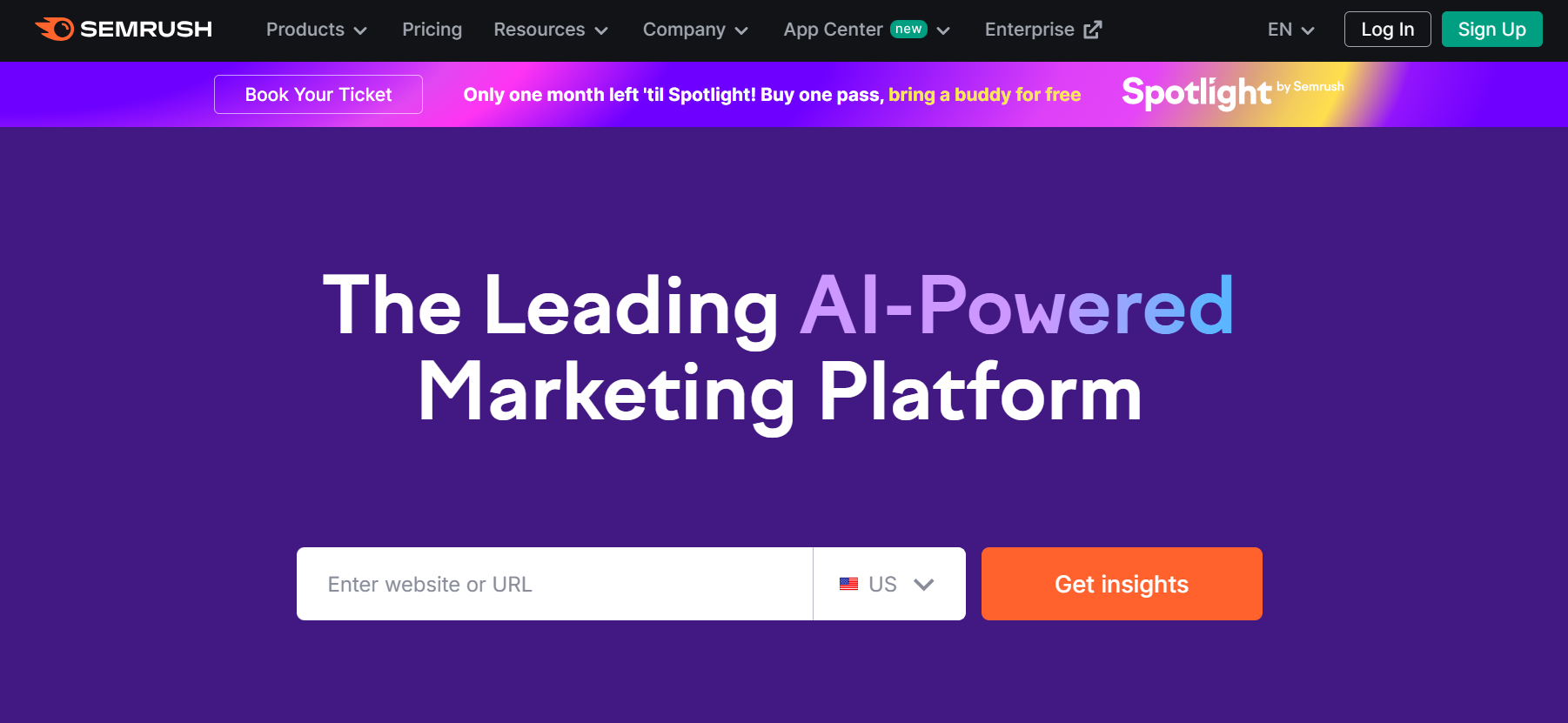
Best For
Semrush is best for a comprehensive digital marketing strategy and full-spectrum competitive analysis, especially for businesses that need to track SEO, PPC, and Content Marketing all in one place. It’s an ideal tool for large teams and agencies looking for a unified, feature-rich platform.
Features of Semrush
- Keyword Research
- Competitor Analysis
- Domain Analysis (Traffic Analytics)
- Organic & Advertising Research
- Backlink Audit & Analysis
- Position Tracking (Rank Tracking)
Semrush Top 3 Features for Competitive Intelligence
1. Organic Research & Keyword Gap Analysis
This core feature allows you to input your domain and competitor domains to instantly see the keywords they rank for, their estimated organic traffic, and your missing keyword opportunities.
2. Traffic Analytics
Semrush’s traffic analytics offers an estimate of a competitor’s total website traffic, traffic sources, and visitor behavior, like bounce rate and time on page.
3. Advertising Research
Semrush pulls detailed data on your competitors' Paid Search (PPC) campaigns. You can see the exact ad copy, the keywords they bid on, their ad spend estimates, and the landing pages they use.
Pros of Semrush for Competitive Intelligence
- Offers an all-in-one platform
- Provides PPC data that many competitors lack, making it excellent for paid strategy analysis
Cons of Semrush
- The vast number of features can feel overwhelming for new users or small businesses with limited scope
- Navigation can be complex for beginners
Pricing of Semrush
- Pro: $117.33/month (billed annually)
- Guru: $208.33/month (billed annually)
- Business: $416.66/month (billed annually)
Final Verdict
Semrush is a comprehensive digital marketing platform that excels at providing a unified view of your competition across all major channels. While its complexity and higher entry-level price point might pose a slight barrier for beginners, the depth of its data, especially in paid search and content, makes it a must-have tool for any serious marketing team or agency.
9. Ahrefs
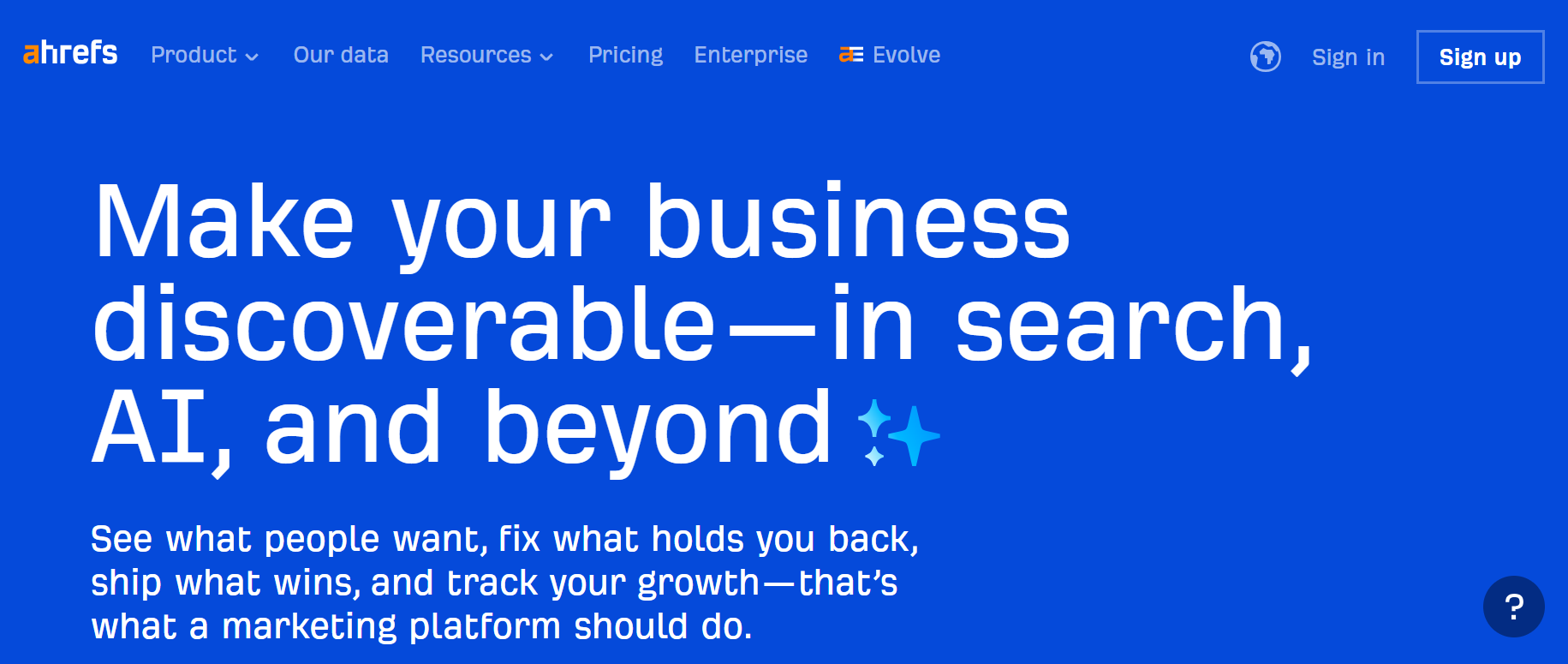
Best For
Ahrefs is the go-to tool for SEO specialists and link-building experts who prioritize the technical and off-page aspects of search visibility.
Features of Ahrefs
- Site & Keywords Explorer
- Rank Tracker
- Content Explorer with Backlink Checker
- SERP Analysis
- Domain Comparison
- Broken Link Checker
Ahrefs Top 3 Features for Competitive Intelligence
1. Site Explorer
By entering a competitor’s domain, you instantly see their organic search performance, the pages driving the most traffic, their backlink profile, and what they are doing in paid search.
2. Backlink Checker (Within Site Explorer)
Ahrefs' backlink data shows you every site that links to your competitors, the anchor text used, and the link's power (Domain Rating).
3. Keywords Explorer
Ahrefs provides in-depth data on any keyword, including its difficulty score, estimated search volume, and traffic potential.
Pros of Ahrefs for Competitive Intelligence
- Advanced tools for quick automation
- Clean, fast, and easy to navigate
Cons of Ahrefs
- Less focused on non-search-related marketing areas like social media or general market analysis
- Credit-based usage system can limit the amount of research you can do before incurring extra costs
Pricing of Ahrefs
- Lite: From $129/month
- Standard: From $249/month
- Advanced: From $449/month
- Enterprise: From $1499/month
Final Verdict
Ahrefs is the benchmark tool for anyone focused on organic SEO and link building. While it may not offer the all-in-one digital marketing breadth of a platform like Semrush, its backlink and organic keyword data is incredibly deep and accurate.
10. Owletter
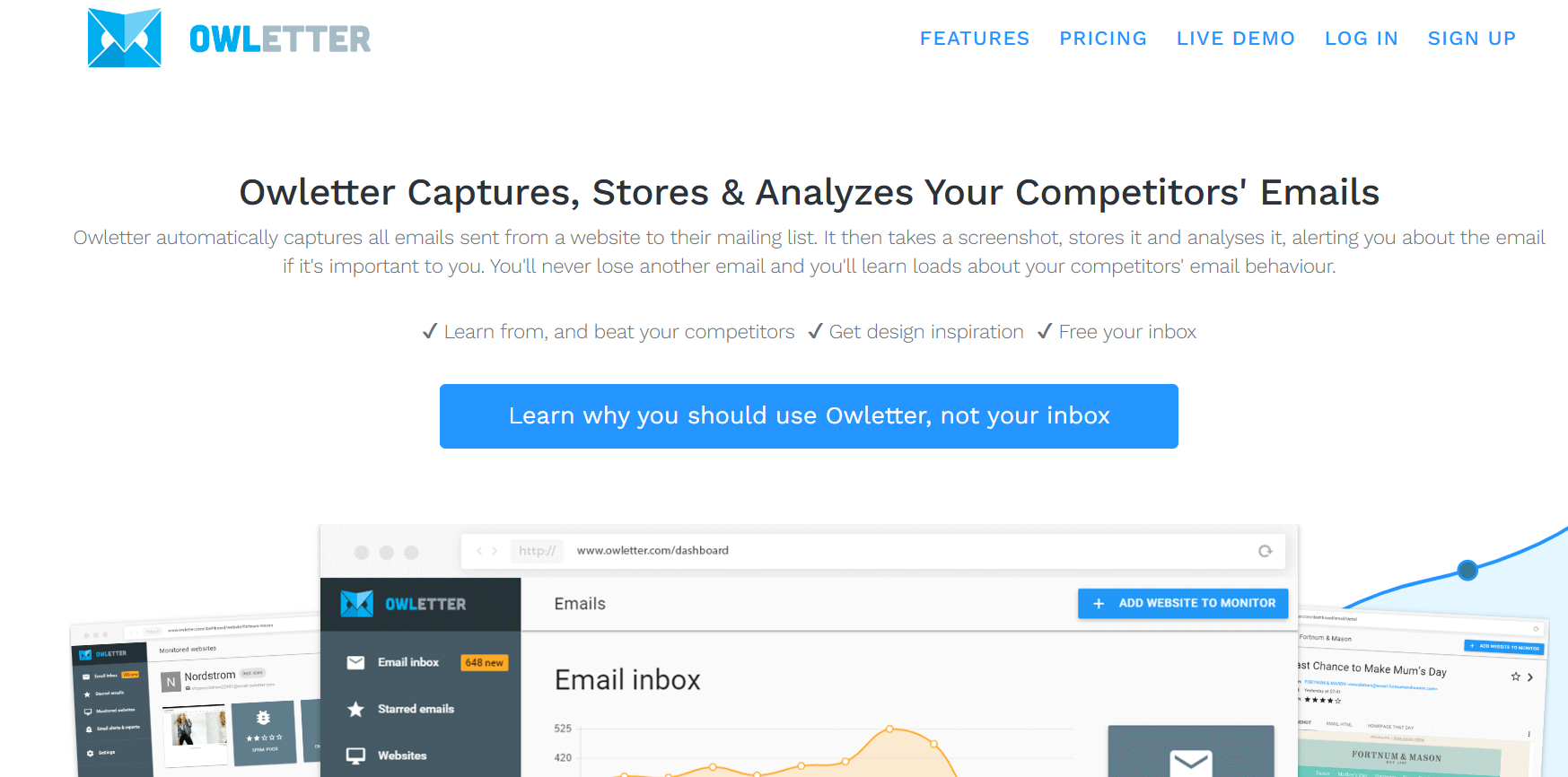
Best For
Owletter is best for competitive email marketing intelligence for marketers whose competitive analysis strategy requires a deep dive into what their rivals are sending to their email lists.
Features of Owletter
- Automated Email Archiving
- Email Frequency Analysis
- Email Screenshots
- Alert Emails and Instant Notifications
- Monthly/Weekly Summary Emails
- Competitor Email Analytics
Owletter Top 3 Features for Competitive Intelligence
1. Automated Email Capture and Archiving
Owletter takes over the tedious work of subscribing to competitor newsletters and makes sure you never miss an email. It captures, stores, and archives every single email your competitors send, allowing you to look back at their campaigns over months or even years.
2. Email Frequency and Trend Analysis
Owletter analyzes your competitor's sending patterns, revealing how frequently they send emails and if their schedule changes with seasonality or specific promotions.
3. Keyword Alerts
You can set up alerts to notify you immediately when a competitor sends an email containing specific keywords, like a product name, a price change, a new feature, or a special offer.
Pros of Owletter for Competitive Intelligence
- Simplifies and cleans up competitive email monitoring
- Provides historical data for deep long-term trend analysis.
- Offers visual screenshots and analytics
Cons of Owletter
- It is a single-focus tool; it only monitors email campaigns
- Cannot track performance metrics like open rates or clicks, as that data is private to the sender
Pricing of Owletter
*Pricing is based on monthly rates; annual billing may offer a discount.*
- Starter: $29/month - 10 websites monitored
- Business: $49/month - 25 websites monitored
- Agency: $99/month - Unlimited websites monitored, unlimited features
Final Verdict
Owletter is a focused competitive intelligence tool for any marketer serious about email strategy. It completely removes the manual headache of tracking competitor emails and provides clean, actionable insights into their messaging and timing. While it is limited to email and doesn't track website changes or price adjustments like a broader tool (a small gap that ScrapX can help fill), it performs the core functions.
Key Features to Look for in Competitive Intelligence Tools
When selecting a tool to stay ahead of the curve, it’s easy to get lost in a sea of features. Here are the key features you should prioritize, especially for tactical, real-time competitive analysis:
1. Real-Time and Customized Change Detection
The single most valuable piece of competitive intelligence is knowing about a critical change as soon as it happens, not days or weeks later. A good tool must move beyond simple SEO rankings to monitor the actual content of a competitor’s site.
ScrapX specializes in this deep-dive monitoring. It doesn't just check if a page is up; it uses Textual Change Detection to pinpoint the exact words, numbers, or sentences that have been added, removed, or edited. This lets you catch a competitor's price drop, new feature announcement, or a change in their shipping policy the minute they publish it.
2. Monitoring Beyond the Main Website (Hidden Data)
Look for tools that monitor technical elements and secondary domains that signal a change in direction. This includes tracking new subdomains, which can indicate new product launches, a rebrand, or expansion into a new market.
3. Visual and Non-Textual Monitoring
The right competitive intelligence tool should have the capacity to take snapshots of a web page and compare them visually, highlighting areas where the design, images, or layout have changed.
ScrapX offers Visual Change Detection to alert you when a competitor modifies their site's look and feel. This is essential for quickly spotting a new conversion-focused design, a refreshed brand identity, or the new screenshots of an upcoming product feature, all before the official press release hits.
4. Smart Filtering and Data Transformation
It is important to look for features that allow you to set rules to filter out irrelevant changes (like minor footer updates) and extract specific data points (like just the price number) into a clean, easy-to-use format.
ScrapX uses advanced Transformers to refine the data. You can strip away HTML, run clean-up on the text, and even run custom code to ensure the notification you receive contains only the specific data point you care about, drastically reducing noise and improving efficiency.
Best Practices for Competitor Monitoring
Here are quick, actionable tips for effective competitor monitoring:
- Monitor only pages that signal strategic change: Pricing, Features, and Terms of Service.
- Use instant alerts to react immediately to price drops or new campaigns.
- Look for non-obvious signals like changes in Sub-Domains and new Job Postings to predict future moves.
- Use tools like ScrapX to apply Transformers that isolate the specific data point (e.g., just the new price), ensuring you only get relevant, clean intelligence.
- Store historical data to analyze long-term patterns, seasonality, and core strategy shifts over time.
How to Choose the Right Competitive Intelligence Tool for Your Business
Selecting the right competitive marketing intelligence tool depends on aligning its core capabilities with your needs. Prioritize platforms that offer accurate, real-time alerts and flexible data extraction. A strong tool must move beyond basic SEO analysis to include deep website change monitoring, visual tracking, and the ability to integrate into your workflow via API/Webhooks.
Final Thoughts
In the complex market of digital competition, staying ahead requires moving beyond basic SEO reports.
Tools like Semrush and Ahrefs are vital for high-level organic strategy, but they often miss the real-time, tactical moves that determine market share. ScrapX fills this critical gap by providing real-time change detection and precise data extraction from competitor websites. If you need instant alerts on pricing, product changes, or security updates, ScrapX provides the clarity and speed you need to act instantly.
FAQs
1. How do competitor website changes affect my SEO performance?
Competitor website changes impact your SEO in several ways. When a competitor launches a new product page, updates their messaging, or adds schema markup, they can gain better visibility in the SERP. More critically, if they lower prices, you must know immediately to prevent customer churn.
2. What is the difference between SEO analysis and website change monitoring?
SEO analysis focuses on long-term, public metrics: keyword rankings, traffic estimates, and backlink authority. Website change monitoring focuses on real-time, granular, and actionable tactical data: the exact price, a new feature description, or a change in their legal policy. Both are essential for a complete strategy.
3. Why is tracking a competitor’s sub-domains important for competitive intelligence?
New sub-domains are frequently used to quietly launch new products, test new features, or expand into new markets before a formal announcement. Sub-Domain Change Alerts provide an early warning signal of a strategic direction, giving you time to prepare your counter-marketing or product strategy.
4. What role does AI and SGE (Search Generative Experience) play in competitive intelligence today?
AI-powered search features like SGE often pull short, clear, block-style answers from across the web. To compete for this premium AEO (Answer Engine Optimization) visibility, you must monitor which competitor pages are being used in these generative answers. Furthermore, the best CI tools use AI/ML (like ScrapX's Transformers) to filter out noise, ensuring you only receive high-signal, actionable intelligence.
5. Should I monitor my own website's technical health as part of competitive intelligence?
Yes. If you have an expiring SSL certificate, slow loading pages, or broken links, it will erode any competitive advantage you gain. Monitoring your own technical signals like SSL Cert Alerts is crucial to ensure you don't lose sales or trust due to preventable errors.
6. Can I monitor competitor pricing on large e-commerce sites efficiently?
Manual price checks are impossible for high-volume sites. Effective competitive intelligence tools should have strong data extraction capabilities. You need a platform that can target the specific HTML element containing the price and extract only that number, ignoring all surrounding text, so you can feed clean pricing data directly into your own dynamic pricing or monitoring systems.